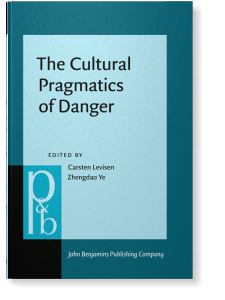The Cultural Pragmatics of Danger
Cross-linguistic perspectives
This book addresses the problems and challenges of studying the discourse of "danger" cross-linguistically and cross-culturally, and proposes the cultural pragmatics of danger as a new field of inquiry. Detailed case studies of several linguacultures include Arabic, Chinese, Danish, English, German, Japanese and Spanish. Focusing on global and local contexts surrounding “living in dangerous times”, this book showcases how the new model of cultural pragmatics can be used to illuminate cultural meanings in discourse. Unlike the universalist approaches to pragmatics, cultural pragmatics focuses on understanding the linguacultural logics of discourse, and in the case of “danger”, the multiple cultural logics around which the themes and domains of “danger” revolve. The approach makes use of natural semantic metalanguage (NSM) as its principal analytical tool, and concepts such as “cultural keywords” and “cultural scripts” figure prominently as bearers of culture-specific meanings.
The book will be of interest to students of pragmatics and discourse studies, researchers in cultural and cognitive semantics, anthropological linguistics, global humanities, political rhetoric and environmental studies, as well as linguists working in applied areas, such as risk and disaster studies, crisis and emergency communication.
The book will be of interest to students of pragmatics and discourse studies, researchers in cultural and cognitive semantics, anthropological linguistics, global humanities, political rhetoric and environmental studies, as well as linguists working in applied areas, such as risk and disaster studies, crisis and emergency communication.
[Pragmatics & Beyond New Series, 346] 2024. vii, 251 pp.
Publishing status: Available
© John Benjamins
Table of Contents
-
Acknowledgements | pp. vii–viii
-
Chapter 1. “When bad things happen to people”: Cultural pragmatics and cross-linguistic perspectives on dangerCarsten Levisen and Zhengdao Ye | pp. 1–22
-
Chapter 2. Society in danger: Samfundssind ‘community spirit’ and the cultural pragmatics of Danish pandemic discourseCarsten Levisen | pp. 23–40
-
Chapter 3. A Japanese pragmatics of danger: The rise of jishuku ‘self-discipline’ and dōchō-atsuryoku ‘peer-pressure’ as pandemic keywords in JapanYuko Asano-Cavanagh and Robert F. Cavanagh | pp. 41–63
-
Chapter 4. New social categories in dangerous times: Unidad familiar, conviviente, and grupo burbuja in Spain’s “New Normal”Mónica Aznárez-Mauleón | pp. 64–85
-
Chapter 5. Superheroes, war heroes, health care heroes: The pragmatics of danger and the discourse of heroismLauren Sadow and Katie Cox | pp. 86–106
-
Chapter 6. Emergency messaging and dangerous translations: Case studies of Australian Covid-19 discourseIda Stevia Diget | pp. 107–134
-
Chapter 7. Language learning in times of danger: Narratives of confinamiento/confinement in Spanish – English bilingual online conversations during lockdownSusana S. Fernández and Christine Appel | pp. 135–157
-
Chapter 8. Planet in danger! Climate emotions in English: A cultural pragmatics study of eco-anxiety, grief and distressHelen Bromhead | pp. 158–174
-
Chapter 9. Alla yustur: Danger-thwarting divine interjectional phrases in Jish ArabicSandy Habib | pp. 175–193
-
Chapter 10. The cultural pragmatics of “danger” in Chinese political discourseZhengdao Ye | pp. 194–216
-
Chapter 11. Security, Sicherheit, ānquán: Similar-but-different key concepts in English, German and ChineseCliff Goddard, Tine-Marie Junker and Zhengdao Ye | pp. 217–235
-
Epilogue: Beyond dangers and disasters: Further reflections and a guide for future research in cultural pragmaticsCarsten Levisen and Zhengdao Ye | pp. 236–242
-
Index | pp. 243–251
Subjects
Communication Studies
Main BIC Subject
CFG: Semantics, Pragmatics, Discourse Analysis
Main BISAC Subject
LAN009030: LANGUAGE ARTS & DISCIPLINES / Linguistics / Pragmatics
